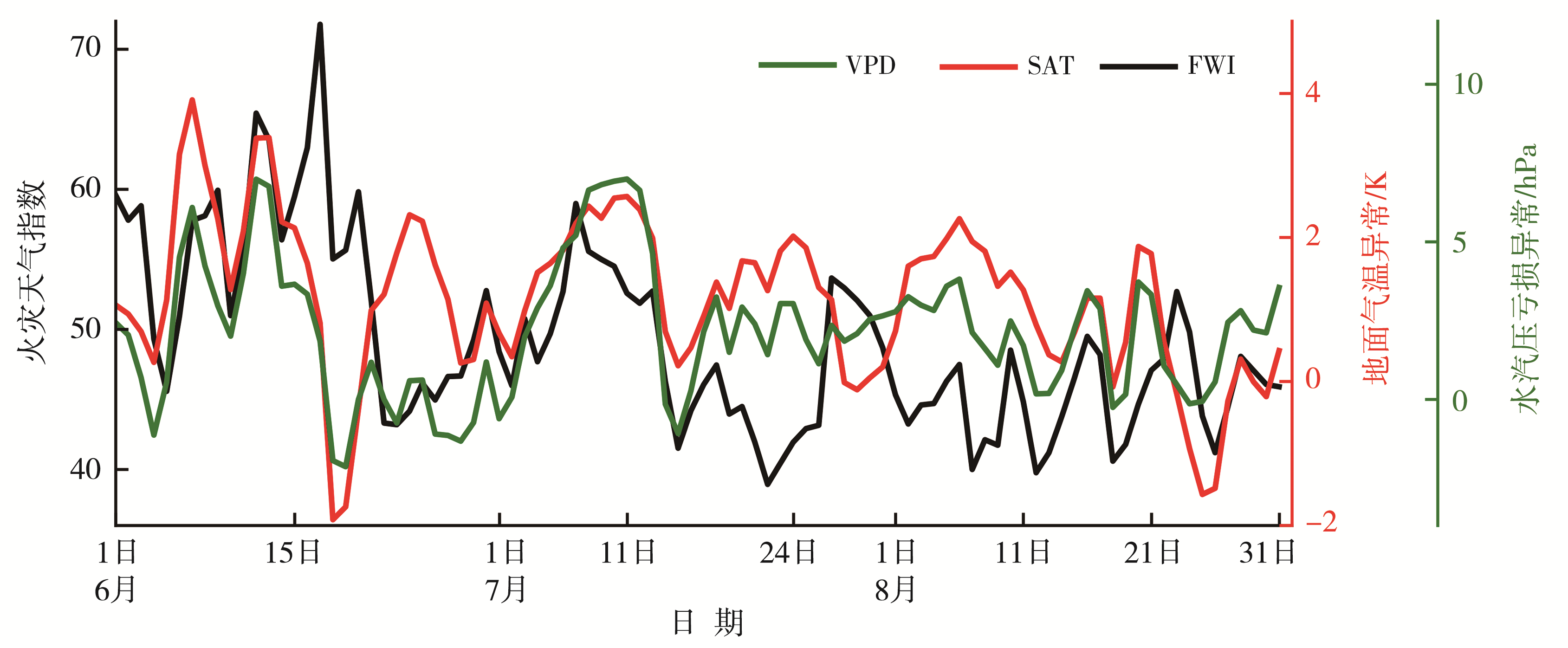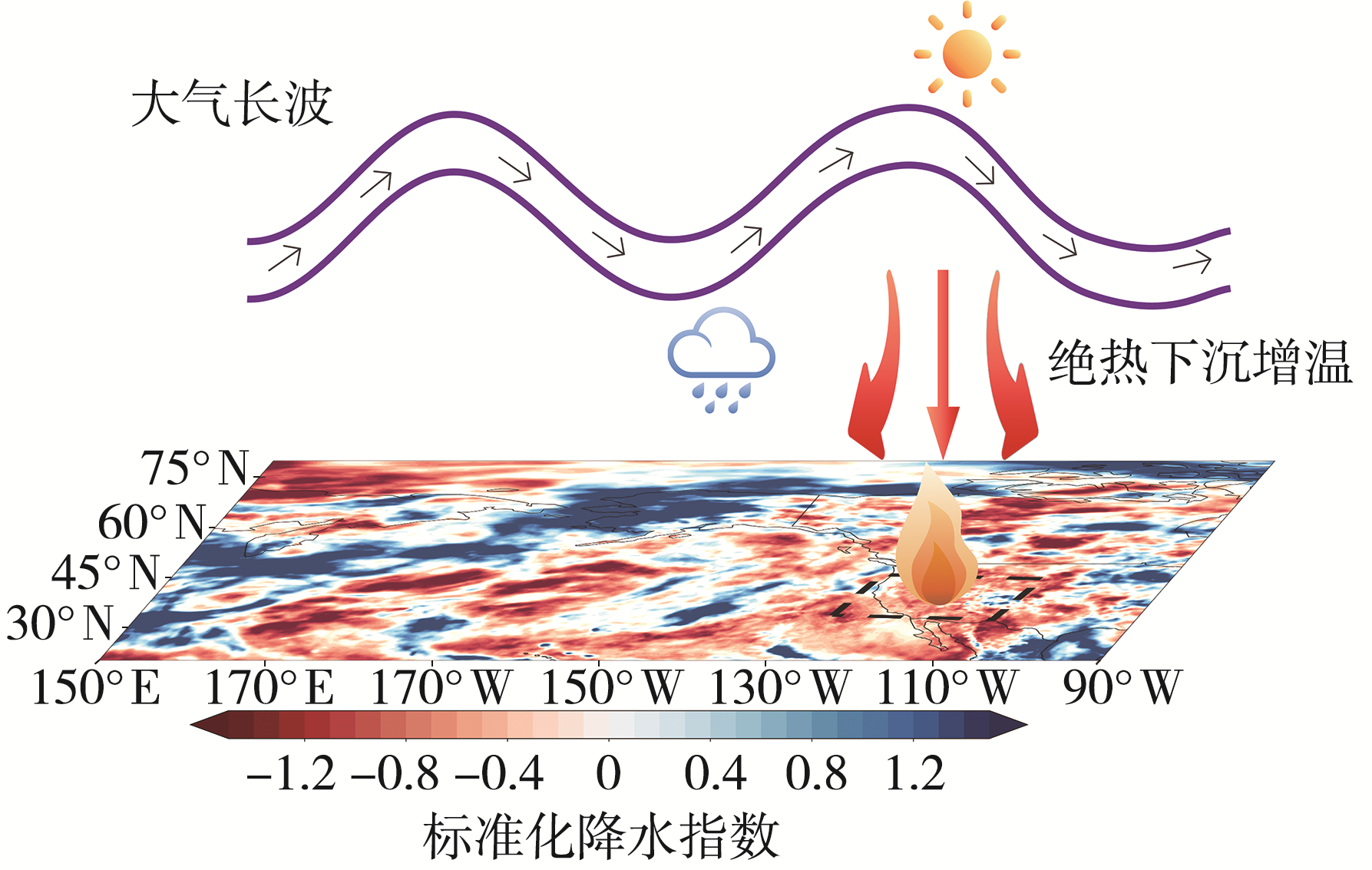| [1] |
李春华, 朱飙, 杨金虎, 等, 2024. 我国干旱半干旱区近60 a气象干旱气候特征分析[J]. 干旱气象, 42(4):519-526.
DOI
|
| [2] |
林纾, 李红英, 黄鹏程, 等, 2022. 2022年夏季我国高温干旱特征及其环流形势分析[J]. 干旱气象, 40(5):748-763.
DOI
|
| [3] |
刘洋鹏, 罗斯生, 吴泽鹏, 等, 2025. 广东省森林火灾形势与应对措施探讨: 基于美国加州大火启示分析[J]. 森林防火, 43(3):64-67.
|
| [4] |
钱维宏, 2012. 天气尺度瞬变扰动的物理分解原理[J]. 地球物理学报, 55(5):1 439-1 448.
|
| [5] |
钱维宏, 单晓龙, 朱亚芬, 2012. 天气尺度扰动流场对区域暴雨的指示能力[J]. 地球物理学报, 55(5):1 513-1 522.
|
| [6] |
钱维宏, 张宗婕, 2012. 西南区域持续性干旱事件的行星尺度和天气尺度扰动信号[J]. 地球物理学报, 55(5):1 462-1 471.
|
| [7] |
田永丽, 王秋华, 2019. 气象条件异常对美国加利福尼亚州山火的影响[J]. 森林防火, 37(3): 21-25.
|
| [8] |
颜鹏程, 李忆平, 曾鼎文, 等, 2024. 2024年4—6月我国区域性高温干旱特征及其影响因子[J]. 干旱气象, 42(4):507-518.
DOI
|
| [9] |
张强, 黄建平, 杨金虎, 等, 2025. 中国干旱、半干旱区气候变化及影响研究百年进展[J]. 气象学报, 83(3):699-715.
|
| [10] |
周扬, 李宁, 吉中会, 等, 2013. 基于SPI指数的1981—2010年内蒙古地区干旱时空分布特征[J]. 自然资源学报, 28(10):1 694-1 706.
|
| [11] |
ABATZOGLOU J T, WILLIAMS A P, BARBERO R, 2019. Global emergence of anthropogenic climate change in fire weather indices[J]. Geophysical Research Letters, 46(1): 326-336.
DOI
|
| [12] |
BOWRING S P K, JONES M W, CIAIS P, et al, 2022. Pyrogenic carbon decomposition critical to resolving fire’s role in the Earth system[J]. Nature Geoscience, 15,135-142.
DOI
|
| [13] |
CHIODI A M, POTTER B E, LARKIN N K, 2021. Multi-decadal change in western US nighttime vapor pressure deficit[J]. Geophysical Research Letters, 48(15): e2021GL092830. DOI:10.1029/2021GL092830.
|
| [14] |
DU L, LU R Y, 2021. Wave trains of 10-30-day meridional wind variations over the North Pacific during summer[J]. Journal of Climate, 34: 9 267-9 277.
|
| [15] |
DU L, LU R Y, 2022. Distinct intensity of 10-30-day intraseasonal waves over the North Pacific between early and late summers[J]. Atmospheric and Oceanic Science Letters, 15(4): 100204.DOI:10.1016/j.aosl.2022.100204.
|
| [16] |
GRILLAKIS M, VOULGARAKIS A, ROVITHAKIS A, et al, 2022. Climate drivers of global wildfire burned area[J]. Environmental Research Letters, 17(4): 045021. DOI:10.1088/1748-9326/ac5fa1.
|
| [17] |
HERSBACH H, BELL B, BERRISFORD P, et al, 2020. The ERA5 global reanalysis[J]. Quarterly Journal of the Royal Meteorological Society, 146(730):1 999-2 049.
DOI
URL
|
| [18] |
JAIN P, CASTELLANOS-ACUNA D, COOGAN S C P, et al, 2022. Observed increases in extreme fire weather driven by atmospheric humidity and temperature[J]. Nature Climate Change, 12(1): 63-70.
DOI
|
| [19] |
JI F, WU Z H, HUANG J P, 2014. Evolution of land surface air temperature trend[J]. Nature Climate Change, 4(6):462-466.
DOI
|
| [20] |
LUO B H, LUO D H, DAI A G, et al, 2024. Rapid summer Russian Arctic sea-ice loss enhances the risk of recent Eastern Siberian wildfires[J]. Nature Communications, 15: 5399. DOI:10.1038/s41467-024-49677-0.
PMID
|
| [21] |
LUO B H, XIAO C D, LUO D H, et al, 2025. Atmospheric and oceanic drivers behind the 2023 Canadian wildfires[J]. Communications Earth & Environment, 6: 446. DOI:10.1038/s43247-025-02387-x.
|
| [22] |
MACK M C, BRET-HARTE M S, HOLLINGSWORTH T N, et al, 2011. Carbon loss from an unprecedented Arctic tundra wildfire[J]. Nature, 475(7357): 489-492.
DOI
|
| [23] |
PINTO M M, DACAMARA C C, HURDUC A, et al, 2020. Enhancing the fire weather index with atmospheric instability information[J]. Environmental Research Letters, 15(9): 0940b7. DOI:10.1088/1748-9326/ab9e22.
|
| [24] |
SEDANO F, RANDERSON J T, 2014. Multi-scale influence of vapor pressure deficit on fire ignition and spread in boreal forest ecosystems[J]. Biogeosciences, 11(4): 3 739-3 755.
DOI
URL
|
| [25] |
SENANDE-RIVERA M, INSUA-COSTA D, MIGUEZ-MACHO G, 2022. Spatial and temporal expansion of global wildland fire activity in response to climate change[J]. Nature Communications, 13: 1208.DOI:10.1038/s41467-022-28835-2.
|
| [26] |
TAKAYA K, NAKAMURA H, 2001. A formulation of a phase-independent wave-activity flux for stationary and migratory quasigeostrophic eddies on a zonally varying basic flow[J]. Journal of the Atmospheric Sciences, 58(6): 608-627.
DOI
URL
|
| [27] |
TRENBERTH K E, FASULLO J T, SHEPHERD T G, 2015. Attribution of climate extreme events[J]. Nature Climate Change, 5(8): 725-730.
DOI
|
| [28] |
TURETSKY M R, BENSCOTER B, PAGE S S, et al, 2015. Global vulnerability of peatlands to fire and carbon loss[J]. Nature Geoscience, 8(1): 11-14.
DOI
|
| [29] |
VITOLO C, DI GIUSEPPE F, KRZEMINSKI B, et al, 2019. A 1980-2018 global fire danger re-analysis dataset for the Canadian Fire Weather Indices[J]. Scientific Data, 6: 190032. DOI:10.1038/sdata.2019.32.
|
| [30] |
WU Z H, HUANG N E, 2009. Ensemble empirical mode decomposition:A noise-assisted data analysis method[J]. Advances in Adaptive Data Analysis, 1(1): 1-41.
DOI
URL
|
| [31] |
ZHENG B, CIAIS P, CHEVALLIER F, et al, 2023. Record-high CO2 emissions from boreal fires in 2021[J]. Science, 379(6635): 912-917.
DOI
URL
|
 ), 姚玉璧1(
), 姚玉璧1( ), 阳仁贵1, 高瑜昺1, 张伟伟1,6, 邓梦雨3,4, 肖淼元5
), 阳仁贵1, 高瑜昺1, 张伟伟1,6, 邓梦雨3,4, 肖淼元5
 ), YAO Yubi1(
), YAO Yubi1( ), YANG Rengui1, GAO Yubin1, ZHANG Weiwei1,6, DENG Mengyu3,4, XIAO Miaoyuan5
), YANG Rengui1, GAO Yubin1, ZHANG Weiwei1,6, DENG Mengyu3,4, XIAO Miaoyuan5











